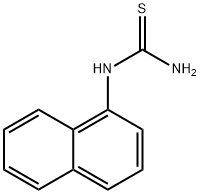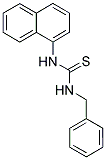ANTU , PESTANAL ,analyticalstandard , 86-88-4
Synonym(s):
N-(1-Naphthyl)thiourea
CAS NO.:86-88-4
Empirical Formula: C11H10N2S
Molecular Weight: 202.28
MDL number: MFCD00041824
EINECS: 201-706-3
PRODUCT Properties
| Melting point: | 193 °C |
| Boiling point: | 377.6±25.0 °C(Predicted) |
| Density | 1.333 |
| refractive index | 1.5500 (estimate) |
| storage temp. | Poison room |
| solubility | 4.3 and 86 g/L in acetone and triethylene glycol, respectively (Windholz et al., 1983) |
| pka | 13.12±0.70(Predicted) |
| form | Crystals or Crystalline Powder |
| color | Grayish to beige-brown |
| Odor | bitter taste |
| Water Solubility | 600 mg/L at 20 °C (quoted, Windholz et al., 1983) |
| Merck | 14,722 |
| BRN | 778118 |
| Exposure limits | NIOSH REL: TWA 0.3 mg/m3, IDLH 100 mg/m3; OSHA PEL: TWA
0.3 mg/m3 |
| Major Application | agriculture environmental |
| InChI | 1S/C11H10N2S/c12-11(14)13-10-7-3-5-8-4-1-2-6-9(8)10/h1-7H,(H3,12,13,14) |
| InChIKey | PIVQQUNOTICCSA-UHFFFAOYSA-N |
| SMILES | NC(=S)Nc1cccc2ccccc12 |
| CAS DataBase Reference | 86-88-4(CAS DataBase Reference) |
| IARC | 3 (Vol. 30, Sup 7) 1987 |
| EPA Substance Registry System | .alpha.-Naphthylthiourea (86-88-4) |
Description and Uses
a-Naphthylthiourea (ANTU; also called DIRAX) is toxic by inhalation, ingestion, or skin contact. Due to its very narrow spectrum of activity, production was discontinued a long time ago. Exposure to ANTU causes pulmonary edema; therefore, it is often used as an experimental pneumotoxin. ANTU is a graycolored, prism-shaped, odorless powder with a bitter taste. It has a molecular weight of 202.28 and melting point of 200 ℃ and does not ignite readily. However, on interaction with potential oxidizing agents, it may cause fire and explosions, which can lead to hazardous decomposition products such as sulfur dioxide, nitrogen dioxide, and carbon monoxide. The structure of ANTU contains the naphthalene chromophore, which absorbs UV light at ~311 nm. This suggests that ANTU can undergo photolysis.
ANTU an organosulfur is a derivative of thiourea. It is a singledose rodenticide that is specifically used against Norway rats as a bait. However, it is futile against all other species of rodents. Because of its tendency to cause resistance and specificity only toward Norway rodents, this poison rapidly lost popularity and is no longer manufactured in the United States.
Safety
| Symbol(GHS) |   GHS06,GHS08 |
| Signal word | Danger |
| Hazard statements | H300-H351 |
| Precautionary statements | P201-P202-P264-P270-P280-P301+P310 |
| PPE | Eyeshields, Faceshields, Gloves, type P2 (EN 143) respirator cartridges |
| Hazard Codes | T+ |
| Risk Statements | 28-40 |
| Safety Statements | 28-36/37-45-25-23 |
| RIDADR | 1651 |
| OEB | C |
| OEL | TWA: 0.3 mg/m3 |
| WGK Germany | 2 |
| RTECS | YT9275000 |
| TSCA | TSCA listed |
| HazardClass | 6.1 |
| PackingGroup | I |
| HS Code | 29309090 |
| Storage Class | 6.1A - Combustible, acute toxic Cat. 1 and 2 very toxic hazardous materials |
| Hazard Classifications | Acute Tox. 2 Oral Carc. 2 |
| Hazardous Substances Data | 86-88-4(Hazardous Substances Data) |
| Toxicity | Acute oral LD50 for Norwegian rats 6–8 mg/kg (Hartley and Kidd, 1987). |
| IDLA | 100 mg/m3 |





